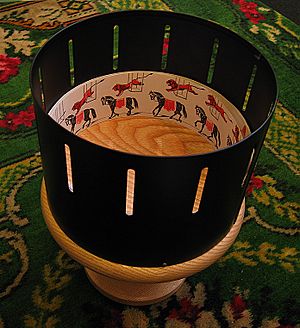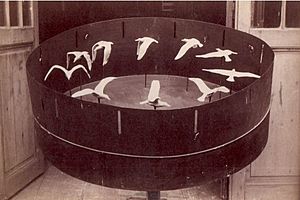Zoetrope facts for kids
A zoetrope is a cool old invention that makes pictures look like they're moving! It's one of the early tools used before movies were invented. It works by showing a series of drawings or photos that change slightly, one after another, to create the illusion of motion. Think of it like a spinning cylinder with slits, and inside are pictures that seem to come alive when you look through the slits as it spins. The zoetrope was first thought of in 1833, but a popular version that was easy to use came out as a toy in 1866 by Milton Bradley and became very successful.
Contents
What's in a Name?
The word zoetrope comes from two ancient Greek words: zoe, which means "life," and tropos, which means "turning." So, it basically means "wheel of life." The inventor William E. Lincoln gave it this name.
How Does a Zoetrope Work?
A zoetrope is a cylinder with thin, vertical slits cut into its sides. Inside the cylinder, there's a strip of paper with a sequence of pictures. When you spin the cylinder and look through the slits, you see the pictures on the opposite side. The slits act like a shutter, showing you each picture for a tiny moment. This quick change of images makes them blend together in your mind, creating the illusion that the pictures are moving! The faster it spins, the smoother the animation looks.
Over time, people made different kinds of zoetropes. Some were "linear zoetropes," which are straight instead of round, and others were "3D zoetropes," which use actual models instead of flat pictures.
Early Ideas for Moving Pictures
People have been fascinated by making images move for a very long time!
Ancient Iranian Bowl
More than 5,000 years ago, an old earthenware bowl from Iran was decorated with a series of pictures showing a goat jumping towards a tree and eating its leaves. Some people think this might be an early idea for animation. If the bowl spun very fast and you looked at it in a special way, the goat might have seemed to move. But we don't know for sure if the artist planned this.
Chinese "Magic" Lamps
In China, about 2,000 years ago, a clever engineer named Ding Huan made a lamp that had pictures of birds and animals. When the lamp got hot, it made the pictures spin and move "quite naturally." Later, similar lamps called "trotting horse lamps" became popular. These lanterns had cut-out figures inside that spun when hot air from a lamp rose. Their shadows would move on the lantern's sides. While these lamps showed movement, they didn't create animation in the same way a zoetrope does, where one picture quickly replaces another.
John Bate's Device (1634)
In 1634, a book by John Bate described a simple device. It had pictures on a card attached to a wheel. Heat from inside a glass cylinder made the wheel turn, making the images seem like "living creatures by their motion." This was similar to some later toys that spun when blown on, making pictures appear to move.
Who Invented the Zoetrope?
Several people had similar ideas around the same time!
Simon Stampfer (1833)
Simon Stampfer, who helped invent the "stroboscope discs" (another early animation device), suggested in 1833 that moving pictures could be put on a disc, a cylinder, or even a long strip of paper. He ended up publishing his invention as a disc.
William Horner (1834)
A British mathematician named William George Horner came up with a cylindrical version in 1834. He called his device the Dædaleum, named after Daedalus from Greek myths. Horner's drum had viewing slits between the pictures.
William Lincoln & Milton Bradley (1865)
The zoetrope we know best was invented by William Ensign Lincoln in 1865 when he was about 18 years old. Lincoln's clever idea was to put the viewing slits above the pictures. This made it easy to change the picture strips inside the cylinder. He sent his idea to the Milton Bradley Company, a famous game maker. They started selling the Zoëtrope in 1866, and it quickly became a huge hit!
James Clerk Maxwell's Improvement
In 1868, James Clerk Maxwell, a famous scientist, made an improved zoetrope. Instead of slits, it used special lenses. This made the images look much clearer and steadier. Maxwell even drew strips that showed physics concepts, like how a harp string vibrates. His improved zoetrope was never sold to the public, but his original one is kept in a museum in Cambridge.
Linear Zoetropes
Imagine a zoetrope that's straight instead of round! A linear zoetrope is a long, straight screen with thin vertical slits. Behind each slit is an image. As you move past the display (like on a train), you see a motion picture. These can have very long animations and make images look wider than they really are.
Subway Zoetropes
Linear zoetropes have been used in subway tunnels to show advertisements or art!
- Japan: In the early 1990s, you could see linear zoetrope ads in Japan, for example, on the train line to Narita airport.
- United States:
* In 1980, filmmaker Bill Brand created a linear zoetrope called the "Masstransiscope" in an old subway station in New York City. It has 228 slits, and behind each is a hand-painted panel. Train riders see a motion picture as they pass by. It was fixed up in 2008 and is still there! * In 2001, Joshua Spodek designed a linear zoetrope for the Atlanta subway system. It was nearly 980 feet (300 meters) long and showed an advertisement that lasted about 20 seconds. His designs soon appeared in subways across North America, Asia, and Europe. * Other cities like Washington D.C., New Jersey (PATH train), and San Francisco (BART) have also used these cool zoetrope ads in their subway tunnels. * The New York City Subway also had digital linear zoetropes as art projects, like "Bryant Park in Motion" (2010) and "Union Square in Motion" (2011).
- Other Places:
* The Kyiv Metro in Ukraine had a zoetrope ad for a mobile phone company around 2008, but it was taken down quickly. * In Mexico City, Mexico, an ad for the Honda Civic used a zoetrope effect in a subway tunnel. * The Skymetro at Zurich Airport in Switzerland also has a linear zoetrope.
3D Zoetropes
3D zoetropes take the idea of moving pictures to another level by using three-dimensional models instead of flat images! In 1887, Étienne-Jules Marey used a big zoetrope to animate plaster models of birds flying.
Modern 3D zoetropes often don't use a slitted drum. Instead, they use a rapidly flashing strobe light to light up the models. The models are placed on a spinning base. The light flashes on and off very quickly as each model passes the same spot. This makes each model look like a single, moving object. It's a really cool effect!
Ghibli Museum
The Ghibli Museum in Tokyo, Japan, has an amazing 3D zoetrope. It features characters from the animated movie My Neighbour Totoro. This zoetrope helps explain how animation works and shows historical animation devices.
Pixar's Toy Story Zoetropes
Pixar, the animation studio, was inspired by the Ghibli zoetrope and created its own 3D zoetrope for a traveling exhibition. It features characters from Toy Story 2. Pixar made two more 3D zoetropes that you can view from all sides (360 degrees). One was at Disney California Adventure and is now at the Walt Disney Studios Lot. The other was at Hong Kong Disneyland and is now at Disneyland Paris. The original Toy Story zoetrope has traveled to many museums and galleries around the world since 2005!
All Things Fall
All Things Fall is a unique 3D printed zoetrope created by British artist Mat Collishaw. It's inspired by an old painting called The Massacre of Innocents. This artwork is made of steel, aluminum, plaster, and resin, lit by LED lights, and powered by an electric motor.
Peter Hudson's Art Installations
Artist Peter Hudson has created many interactive 3D stroboscopic zoetrope art installations since 2002.
- His first was Sisyphish (2002), a human-powered zoetrope that used strobe lights to animate human figures swimming on a large spinning disk. It was first shown at the Burning Man festival in Nevada.
- He has also created Deeper (2004), Homouroboros (2007), Tantalus (2008), and Charon (2012).
- The Charon zoetrope is huge, standing 32 feet (about 10 meters) high and weighing 8 tons! It looks like a Ferris wheel and features twenty rowing skeleton figures, representing the mythological character Charon who carries souls across the river Styx.
- Hudson's newest zoetrope, Eternal Return, took two years to build and was shown in 2014. His zoetropes are often displayed at festivals and events around the world.
Giant Zoetropes
Some zoetropes have been built on a truly massive scale!
- In 1857, a physics textbook mentioned a cylindrical animation display in Frankfurt that was 18 feet (5.5 meters) across!
- A "Great Zoetrope" that was 50 feet (15 meters) around, with "life-size figures," was set up in the Crystal Palace in London in 1867. It was turned by a gas engine and showed several animations.
- In 2008, a company called Artem Limited built a huge zoetrope for Sony called the BRAVIA-drome. It was 10 meters (about 33 feet) wide and weighed 10 metric tons! It featured 64 images of the famous Brazilian soccer player Kaká. This has been recognized by Guinness World Records as the largest zoetrope in the world.
What Came After the Zoetrope?
The zoetrope was an important step, but other inventions soon followed, leading to modern movies!
- Praxinoscope (1877): Émile Reynaud improved the zoetrope by using an inner circle of mirrors instead of slits. This made the images brighter and clearer.
- Flip Book (1868): Soon after the zoetrope, the flip book was invented. It's simple and compact, and you just flip the pages to see the animation. Flip books are still popular today!
- Chronophotography (1878): Eadweard Muybridge started taking sequential photos of things in motion, like a horse galloping. These photos were sometimes put into zoetropes. Muybridge also invented his own projector called the Zoopraxiscope (1879), which was an early way to project moving images.
- Cinema (1895): The biggest successor to the zoetrope is modern cinema! Auguste and Louis Lumière developed the cinematograph in 1895, which led to the movies we watch today.
- GIF Animation: Today, GIF animations are a bit like modern zoetropes. They are short, looping sequences of images, just like the zoetrope.
Zoetropes Today
Even though we have movies and videos, zoetropes are still used sometimes for art, fun, and even advertising.
- Linear zoetropes and 3D zoetropes are popular for special art projects and exhibits.
- Making a zoetrope is also a common school project. It's a great way to learn about how movies work and the science behind seeing motion.
- Some companies even sell reproductions of old paper zoetropes, bringing this classic toy back to life!
See also
 In Spanish: Zoótropo para niños
In Spanish: Zoótropo para niños



